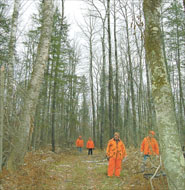Closing coal plants and lack of need in PJM
December 4th, 2009
We all know “need” for electricity is down, down, down:
Take a few minutes and scan that report — it’s telling it like it is. Prices down 40+ % and demand down at least 4+% this year so far (that’s what they’ll admit to, and I figure it’s a lot worse than that!).
Decreased demand was a reason for cutting out the Indian River – Salem part of the MAPP line…
HOT OFF THE PRESS, decreased demand is the reason coal plants are being shut down in Pennsylvania, FOUR coal plants in Pennsylvania:
Exelon to close 4 Penn. generating units by 2011
Alan says that the Eddystone ones are a couple of the first supercritical coal plants around, they’ve been running for ages. But that they’d close down the coal and keep oil-burning units? What gives? Peaking power? Or??? Doesn’t make sense to me. It doesn’t get much dirtier than burning fuel oil. Those have to go too…
Mesaba EIS? And close encounters of the Mesaba kind!
November 17th, 2009
The joint DOE and MN Dept. of Commerce EIS for Excelsior Energy’s Mesaba Project has been released. WTF? This is SUCH a waste of time. And I am at a lost to explain how it is that this even was released, why we have to bother with it, when it’s the vampire-vaporware project from hell that is dead but … but…
Excelsior Energy Mesaba Project Environmental Impact Statement
Comments on the “adequacy of the Final EIS or its impact upon the issues” are due on December 2, 2009. Send Comments to:
steve.mihalchick [at] oah.state.mn.us
or by mail to:
Steve Mihalchick, ALJ
Office of Administrative Hearings
P.O. Box 64620
St. Paul, MN 55164-0620
Here’s the Order establishing that deadline:
Is this weird language or what:
b. Such comments on the “adequacy” of the Final EIS or its “impact” upon the issues in this matter shall be filed with the Administrative Law Judge within ten business days after filing of the Final EIS.
So get cracking on “such comments” and send them in!
And just in, breaking news…
Just last Friday, a MCGPer and his son were out deer hunting on the preferred Excelsior site, guns in hand, on the alert, and what should come bursting through the trees but… BOB EVANS! Bob Evans and two other Excelsior boys, they were out viewing the site during deer hunting! That just doesn’t seem to bright.
Give it up!!! Get a job, Bob!!!
And have they forgotten that other encounter in the woods, almost exactly three years ago?
Meanwhile … the sun is coming up over New York right now…
Sussex County ponders Power Pathway
November 3rd, 2009
Sussex County has held off on taking a formal stand on Delmarva Power’s Mid-Atlantic Power Pathway, or MAPP, but Delmarva is pushing, so now’s the time to call them with a simple message:
No, don’t encourage and facilitate coal!
Say NO! to Delmarva Power’s Mid-Atlantic Power Path transmission proposal!
Delmarva Power is going around drumming up support for its Mid-Atlantic Power Pathway, or MAPP. They approached Sussex County to support the line (what do we know about that? Not much. Perhaps a FOIA to see what they’ve been doing is in order?) and because there’s a zoning matter before the County, they held off..
Delaware Electric Coop would like to use the MAPP line to bring in electricity from a new Old Dominion coal plant in Virginia. Oh… great idea… I’ve posted about this before:
Here’s Alan’s Green Delaware Alert and handout for DEC’s last annual meeting:
Building a coal plant is a really bad idea, and building transmission for coal is a really bad idea plus… two wrongs do not make a right.
Call all the County Council, thank them for putting on the brakes, and let them know what you think about Delmarva Power’s transmission for coal:
Michael H. Vincent (302) 629-2396
Samuel R. Wilson (302) 856-2972
Joan R. Deaver (302) 645-6657
George B. Cole (302) 539-1611
Vance C. Phillips (302) 542-1501
Here’s a report from the Cape Gazette:
Sussex County council delays support of transmission line
Pathway could pump $260 million in county’s economy
Moore responded with an emphatic yes.
He said anticipated savings are about 60 cents per month in charges related to congestion.
Big Stone is dead, dead, dead
November 2nd, 2009
Hot off the press from MDU — there’s contact info at the bottom.
DO SEND THEM CONDOLENCES AND A THANK YOU NOTE!!!
From MPR just now:
And a BSII Press Release found in the inbox:
November 2, 2009
Participating utilities announce wind-down of Big Stone II project
The participating utilities announced today that they will not build the Big Stone II Project, a planned 500-to-600-megawatt coal-fired power plant to be located near Milbank, South Dakota, and its associated transmission. The project required additional participants to move forward; however none have committed.
Big Stone II, a fully permitted project, had been determined to be the least-cost, environmentally sound baseload power plant for the project participants. The project’s high voltage transmission facilities were to be sized to also serve the region’s burgeoning wind energy development.
The Big Stone II Project participants were Central Minnesota Municipal Power Agency, Heartland Consumers Power District, Missouri River Energy Services and Montana-Dakota Utilities Co.
For information specific to each company, contact:
Mark Hanson, Montana-Dakota Utilities Co., 701-530-1093 or mark.hanson@mduresources.com.
Bill Radio, Missouri River Energy Services, 605-731-2522 or billr@mrenergy.com.
Russ Olson, Heartland Consumers Power District, 605-256-6536 or rolson@hcpd.com.
Lori Frisk-Thompson, Central Minnesota Municipal Power Agency, 507-526-2193 or lorift@cmmpa.org.
LS Power’s Sunrise River Energy in the news
November 2nd, 2009
Oct 19 Chisago County meeting re: LS Power Sunrise River Energy Station
How odd… it’s in both STrib and StPPP today… so comment opportunities abound!
Here’s the story from Dennis Lien:
Skeptics question Chisago power plant
Residents fear water pollution, say plans are too vague
By Dennis Lien
Updated: 11/01/2009 11:22:19 PM CSTBut critics have other concerns about what could be the largest natural-gas plant in the state.
And from the STrib’s Tom Meersman:
Protected aquifer feared at risk
It’s about appropriate land use
It can’t be used for industrial purposes in the seven-county metro area.
Others expressed doubts about the company’s change of mind on groundwater use.
Rob Kravitz lives about 2 miles from the site and opposes the plant, period.






